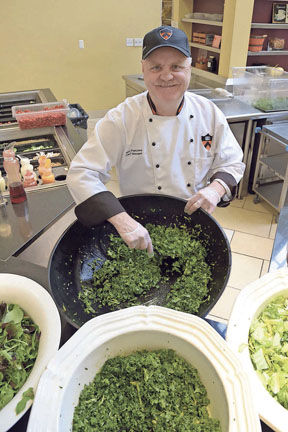By Philip Sean Curran
Inside a wood-paneled dining hall on the Princeton University campus, Smitha Haneef is sitting before a plate of food, and she can identify where everything on that plate came from, starting with where the chicken was raised, where the vegetable was grown and how the sauce was prepared.
It is something she calls “traceability,” part of the nomenclature that she uses as the executive director of campus dining, the head of one of the biggest departments at the university. With 350 employees, campus dining makes sure the students, like the ones sitting at long tables next to Ms. Haneef on a recent afternoon, are well fed and fed well. Their jobs run the gamut from chefs, general managers, dishwashers, catering directors and food service workers.
”Yearly, we serve about 3 million meals on campus,” said Ms. Haneef above the din of students talking to one another. “Food and the way we nourish our campus is very integral to Princeton University. There’s a strong emphasis on how we engage in a residential community. There’s a strong emphasis on our dining experience.”
Undergraduates at Princeton live in six residential colleges located in different parts of the Ivy League campus; they go to dining halls where they can grab a bite to eat at different points in the day.
”We can do approximately 2,000 meals a day between breakfast, lunch and dinner,” said Rick Piancone, the chef manager at the Rocky-Mathey dining hall. “We really try to look at the 18 to 22 year olds, of all the food trends that are happening in the outside.”
Even members of the public can drop in at the Frist Campus Center, one of the locations campus dining manages, located off Washington Road.
Feeding thousands of students daily requires creativity, variety and a nod to socially conscious customers concerned about where their food is coming from and how it is farmed. In terms of how student dining has evolved, Ms. Haneef said she saw changes beginning in the early 2000s.
”I think the students are much more educated eaters, they’re intelligent eaters,” she said. “They’re much more attuned to environmental impact, and they’re much more attuned to the kind of decisions that they make about how they care for themselves through the food they consume.”
Ms. Haneef leads a group of chefs in monthly meetings aimed at asking internal questions, from where should the department innovate, to what new technical expertise they need. She said the university is in a partnership with the Culinary Institute of America to get its chefs the technical knowledge they need and educate them on food trends.
At Princeton, home to a diverse student body that changes with each new class, campus dining looked internally at what it serves. “One of the discoveries was we need to engage our students in the dialogue of food. They give us significant input,” Ms. Haneef said. “Even with the diverse amount of human talent that we have in (the) culinary profession, there is always room to learn.”
An advisory board — made of undergraduate and graduate students — meets with her monthly; she also reads every single comment card that students leave behind.
”We’re always pushing our vendors, through the procurement department that we have at Princeton, for new products,” Mr. Piancone said.
For some students living away from home for the first time, they can find themselves making food choices without Mom or Dad looking over their shoulders. The dreaded “freshman 15,” the extra weight they put on in their first year of college, is common nationwide. Students can get pizza and waffle fries at Princeton if they choose, but they have other options.
”We don’t say ‘don’t eat the waffle fry,’ but we try to nudge them with other healthier choices,” Ms. Haneef said. “We look at campus dining as that platform to nourish them, to educate them, to engage them and make it experiential and real for them.”
As one might expect, students look for a taste of home when dealing with the pressures that come with attending an academically rigorous school.
”There are stressful times when the student does like meatloaf and mashed potatoes during exams, on a cold wintry, snowy day,” Mr. Piancone said. “Comfort food is still important. And we have to keep that in our cycle, knowing that as well.”
Ms. Haneef said the university takes a “holistic approach” to the way it buys its ingredients. She said about 46 percent of all the products come within a 250-mile radius. In making purchasing decisions, the school considers environmental and economic sustainability, taking into account, for example, whether it is supporting local businesses. She cited how the university buys from a fourth-generation pasta company, located about 10 miles away.
Like with anyone else, the university has to deal with rising food prices, be it due to a spike in the price of beef or a harsh winter driving up the cost of lettuce.”All of these things impact our food cost,” she said.
Students have no shortage of options for finding something to eat in Princeton, from the wide range of restaurants in town to the 11 student eating clubs that serve upper classmen. Ms. Haneef said there is a drop in the number of students using dining halls after their sophomore year.
”For us from an institutional perspective, we’re looking at it as across the board are we still able to bring them options in a way that are amenable to them,” she said. “And we see that as a learning and growing experience as well.”

